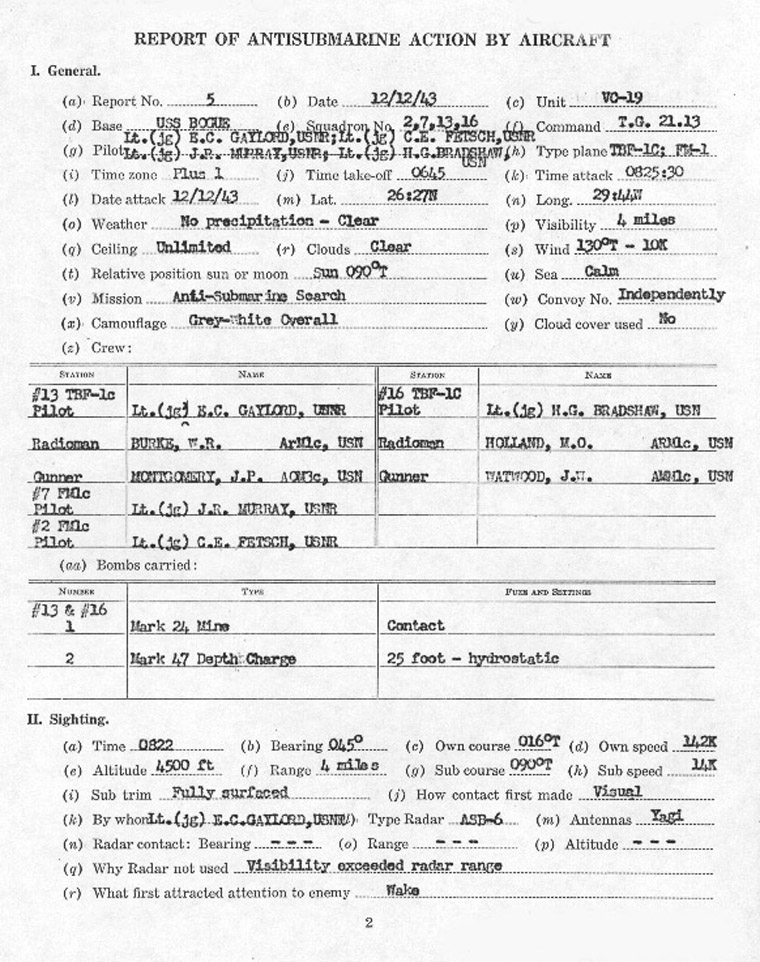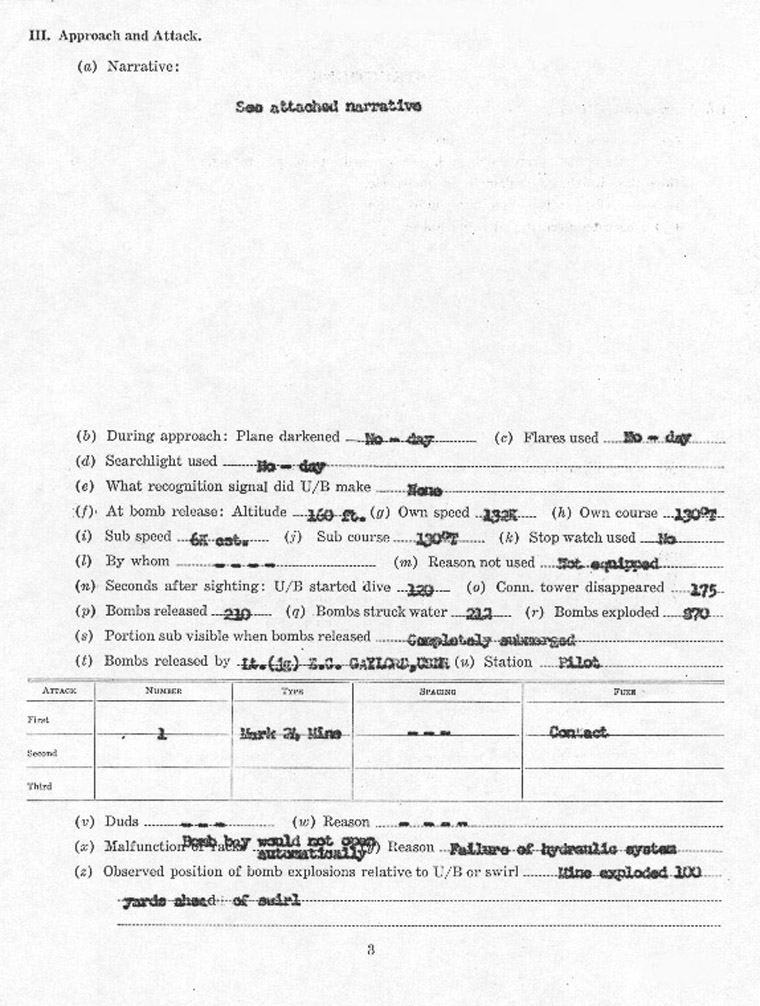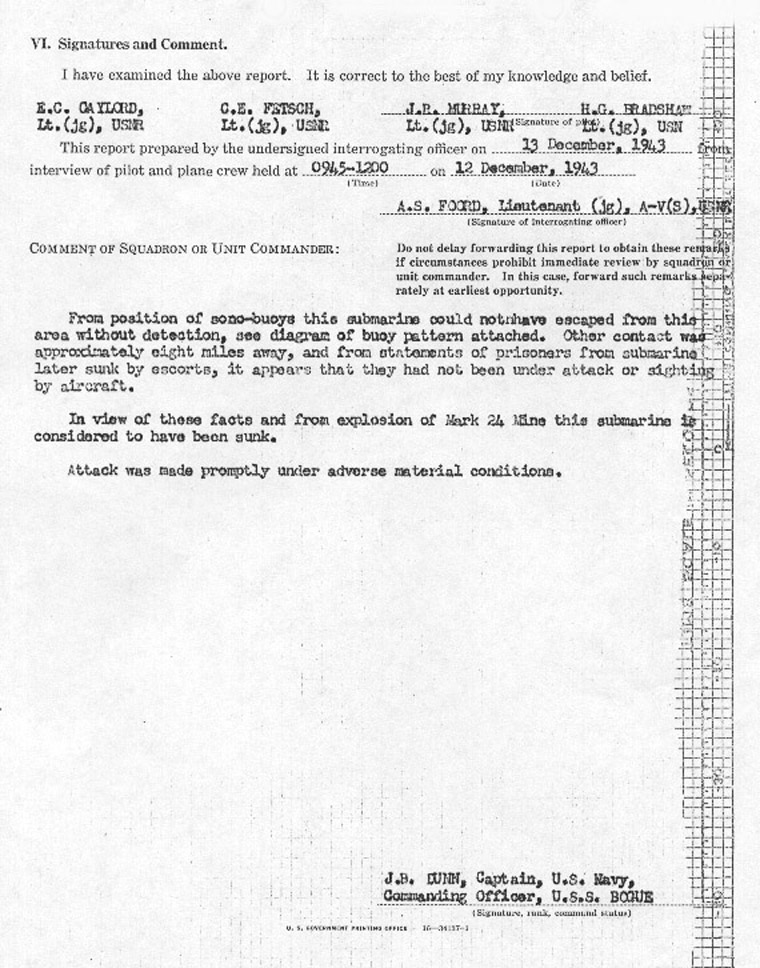

| NARRATIVE OF ATTACK BY LIEUT. (JG) E.C. | ||
| GAYLORD, USNR, on 12 December, 1943 | ||
| On routine anti-submarine search, Lieutenant (jg) E.C. GAYLORD, USNR in Plane #13 sighted a fully surfaced submarine 4 miles away, bearing 0450T, at 0822. He immediately turned toward the submarine, made contact report to U.S.S. BOGUE at 0823, and started a depth charge run. | ||
| Owing to a broken line in the hydraulic system, pilot was unable to open bomb bay doors automatically. When approximately two miles from the submarine, pilot observed the submarine to alter its course from 0900T to 1300T and commence to crash dive at 0824. He therefore switched bombing stations to the Mark 24 Mine, and endeavored to open the bomb bay by the manual pump. | ||
| Because the hydraulic system was out, pilot could not use wheels and flaps to reduce speed for run with mine, and he was therefore obliged to make violent maneuvers and alterations of course to accomplish that object. (See rough track chart attached). He swung around astern of the diving submarine and made an up-track approach. The submarine was slow in getting under, the conning tower disappearing at approximately 0824:55, about 55 seconds after commencement of dive. The bomb bay doors having opened the mine was dropped 35 seconds after the disappearance of the conning tower at 0825:30, and struck the water approximately 15 yards ahead of the swirl. Radioman saw mine run about 10 yards through the water and then dive. | ||
| After the drop, the pilot swung slightly to the left and dropped a sono-buoy approximately 800 yards ahead of the swirl. He then flew around behind the swirl, and it was then observed that the U-boat, in diving, had left an oil slick which mingled with the swirl but did not extend beyond it. | ||
| At 0836:30 the pilot and crew of Plane #13 saw a shock wave 100 yards ahead of the swirl. This was a circular pattern of air bubbles which rose with a gush, approximately 10 feet in diameter, and in the center a small column of spray arose two or three feet above the surface. No sounds were heard on the sono-buoy, but this was because the buoy, for some reason not known, did not begin to operate until 15 minutes later. | ||
Upon receiving Lt.(jg) Gaylord’s contact report at 0823, the BOGUE dispatched aid to the scene. Lt. (jg) Fetsch in Fighter Plane #2 and Lt.(jg) Murry in Fighter Plane #7, who were circling the ship awaiting such a contingency, were vectored to the area of the sighting, which was then 38 miles from the ship, bearing 1900T. At 0838 the U.S.S. DUPONT and at 0842 the U.S.S. GEORGE E. BADGER were ordered to the area. At 0845 Lieutenant (jg) H.G. BRADSHAW in Plane #16 was catapulted and ordered to the scene. |
||
Planes #2 and #7 arrived at 0839 and circled to observe. Plane #16 arrived at 0859 and received orders by radio from ship to lay a large pattern of sono-buoys to see if any indication of the submarine could be picked up. By 0925 the pattern was complete and the buoy dropped by Plane #13 was in operation, but no indications of the presence of a submarine were obtained. |
||
At 0927 the pilots of Planes #2 and #7, who were circling the oil slick at 2500 feet, simultaneously saw the conning tower of a submarine emerge, approximately 400 yards ahead of the slick. The U/Boat did not rise so high that its decks were awash, but only high enough for the upper part of the conning tower to break the surface. |
||
| The pilots immediately vectored Planes #13 and #16 to the spot, but the U/Boat re-submerged within a few seconds, before they could come up. Plane #7 departed to lead the DUPONT and GEORGE E. BADGER, then appearing on the horizon, to the scene, while the other three planes remained in the area. | ||
| At 0936 Planes #2 and #13 were ordered were ordered to return to base. At 0942 Plane #21, catapulted at 0935, arrived and joined up on Plane #16. Planes aided by destroyers DUPONT and GEORGE E. BADGER searched area until 1114 without results. Planes received no indications on sono-buoys, which were in good operating condition, and destroyers made no sound contacts in the area. | ||
